#Princess Maria Antonia of the Two Sicilies
Text

Maria Antonia of Naples and Sicily, Princess of Asturias.
#Maria Antonia of Naples and Sicily#18th century#18th century art#princess of asturias#house of bourbon two sicilies#long live the queue
90 notes
·
View notes
Text








florence + the machine lyrics x colors x textiles in art — blue
Rabbit Heart (Raise It Up) – Lungs // Young Woman in an Armchair – unknown artist 🌊 Swimming – Lungs // Portrait of a Woman in a Blue Dress – unknown artist 🌊 No Light, No Light – Ceremonials // Elisabeth Rachel Félix – Edmond Geffroy 🌊 Spectrum – Ceremonials // Portrait of Maria Christina of the Two Sicilies – Vincente López Portaña 🌊 Bedroom Hymns – Ceremonials // Portrait of Isabella II of Spain – Federico de Madrazo y Kuntz 🌊 What Kind of Man – How Big, How Blue, How Beautiful // Lady in a Blue Dress – Franz Eybl 🌊 How Big, How Blue, How Beautiful – How Big, How Blue, How Beautiful // The Infanta Isabel of Bourbon – Vincente Palmaroli 🌊 Make Up Your Mind, How Big, How Blue, How Beautiful // Portrait of Princess Maria Antonia of Naples and Sicily – Vincente López Portaña
#florence + the machine lyrics x colors x textiles in art#blue#rabbit heart#swimming#no light no light#spectrum#bedroom hymns#what kind of man#how big how blue how beautiful#make up your mind#lungs#lungs album#ceremonials#hbhbhb#florence + the machine#florence and the machine#fatm#art#art history#lyrics#lyric art
265 notes
·
View notes
Photo



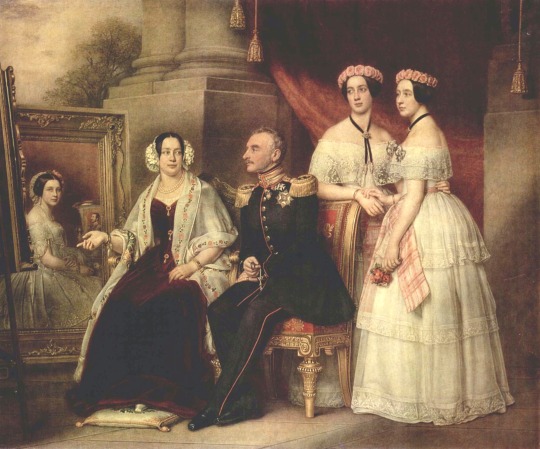



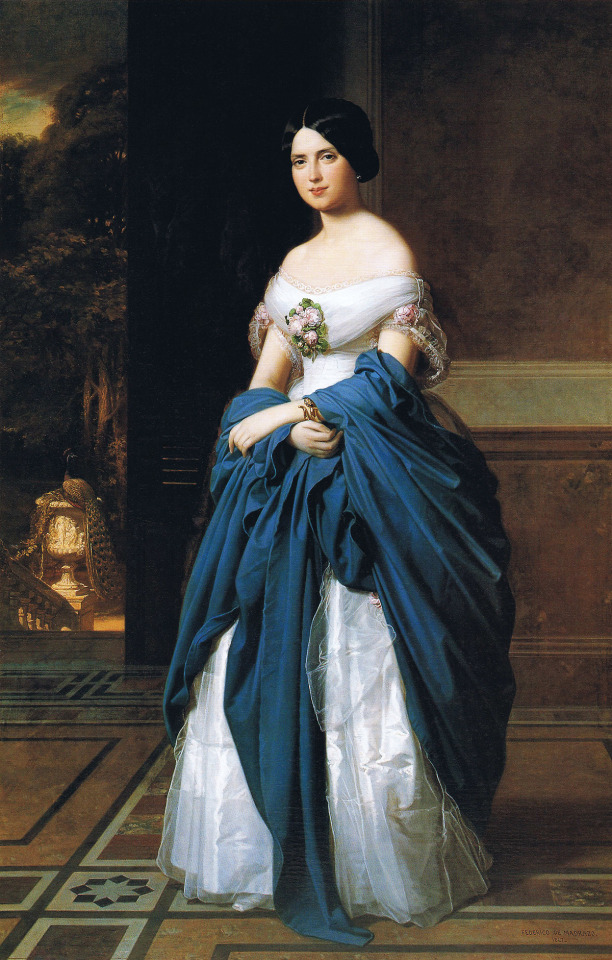
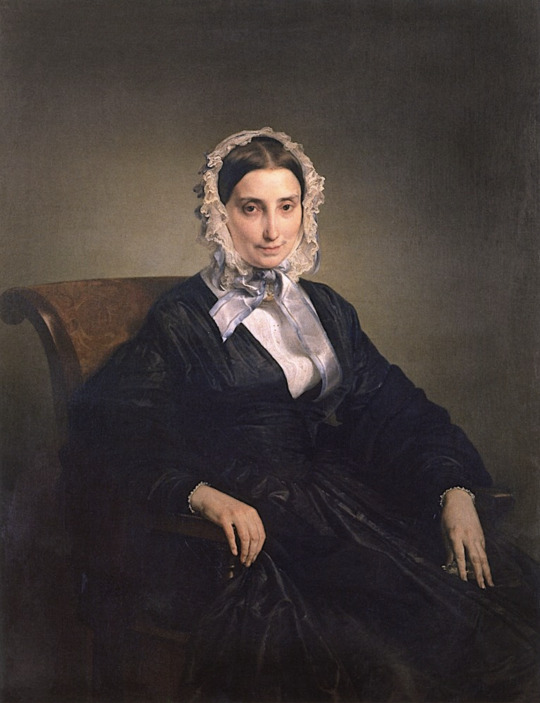

It’s 1847 -
Top: 1847 Anna Pavlovna of Russia by Nicaise De Keyser (Stichting Historische Verzamelingen van het Huis Oranje-Nassau - Den Haag, Zuid-Holland, Netherlands). From Wikimedia 1684X2560 @300 1.1Mj.
Second row left: ca. 1847 Maria Antonia of the Two Sicilies by Giuseppe Bezzuoli (Galleria d'Arte Moderna - Firenze, Toscana, Italy). From Wikimedia; increased sharpness and exposure 990X1216 @72 282kj.
Second row right: ca. 1847 Lady Alexandrina Octavia Maria Vane (1823–1874), Countess of Portarlington by James Godsell Middleton (Mount Stewart - Newtownlands, County Down, Northern Ireland) From bbc.co (now artuk.org); enlarged by half 739X1200 @72 166kj.
Third row: 1847-1848 Duke Joseph von Sachsen-Altenburg family portrait by Joseph Karl Stieler (Hermitage). From Wikimedia; increased exposure 2536X2107 @96 814kj.
Fourth row left: 1847 Lola Montez by Joseph Karl Stieler (Schönheitengallerie, Schloß Nymphenburg - München, Bayern, Germany). From historyofyesterday.com/trouble-in-a-mantilla-and-dancing-slippers-15e39847166; fixed spots & edges w Pshop 1260X1551 @72 378kj.
Fourth row right: 1847 Lola Montez by Carl Buchner (location ?). From Wikimedia 850X1107 @72 429kj.
Fifth row: 1847 María Josefa Corral Suelves, Marquesa de Narros by Federico de Madazo y Kuntz (location ?). From pinterest.com/anavegamedina5/retratos-de-federico-de-madrazo-y-kuntz/; fixed spots & flaws w Pshop 1388X1859 @200 1.6Mj.
Sixth row left: 1847 Leocadia Zamora y Quezada by Federico de Madrazo y Kuntz (private collection). From Wikimedia 1200X1881 @600 1.3Mj.
Sixth row right: 1847-1848 Teresa Borri, widow of Stampa, 2nd wife of Alessandro Manzoni by Francesco Hayez (Pinacoteca Tosio Martinengo - Brescia, Lombadia, Italy). From Art Renewal Center; removed more obvious spots w Pshop 1998X2601 @144 5.1Mp.
Bottom: 1847 Princess Julia Luisa Golitsyna, née Baranov by Franz Schrotzberg (location ?). From Wikimedia; fixed larger spots & flaws w Pshop 1674X2052 @72 1.3Mj.
#1847 fashion#Louis-Phillipe fashion#early Victorian fashion#Biedermeier fashion#Queen Anna Pavlovna#Nicaise De Keyser#tiara#off shoulder V neckline#Maria Antonia of the Two Sicilies#Giuseppe Bezzuoli#Alexandrina Octavia Maria Vane#James Godsell Middleton#Gigot sleeves#Elisabeth of Saxe-Altenburg#Joseph Karl Stieler#Alexandra Iosifovna#Amelia of Württemberg#Lola Montez#Carl Buchner#María Josefa Corral Suelves#Federico de Madazo y Kuntz#Leocadia Zamora y Quezada#Teresa Borri#Francesco Hayez#Julia Luisa Golitsyna#lace bertha
11 notes
·
View notes
Photo
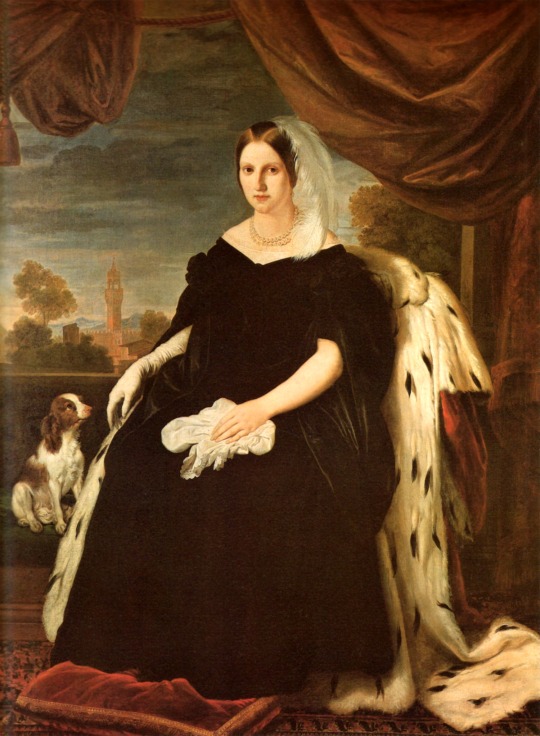
Portrait of Princess Maria Antonia of the Two Sicilies, Grand duchess of Tuscany (1836). Giuseppe Bezzuoli (Italian, 1784-1855). Oil on canvas. Galleria d'arte moderna di Firenze.
Marie Antoinette, the second wife of Grand Duke Leopoldo II of Tuscany, is depicted in her role as a sovereign, dressed in black velvet with a plume in her hair and seated on an ermine coat, a symbol of power. In the background, the belfry of the Palazzo Vecchio and the silhouette of the Duomo indicate the locale of her realm.
22 notes
·
View notes
Text
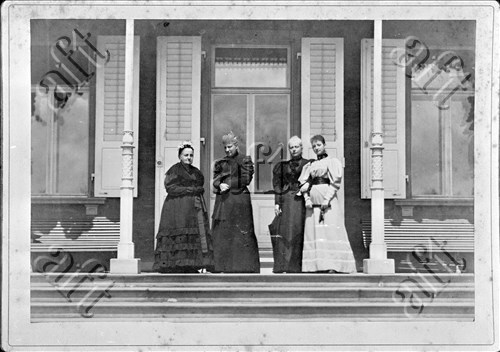
Four generations in 1890 at Villa Toscana, Lindau, Germany.
Maria Antonia Dowager Grand Duchess of Tuscany (1814-1898), Archduchess Maria Isabella Countess of Trapani (1834-1901), Princess Maria Antonietta Countess of Caserta (1851-1938) and Princess Maria Immaculata of Bourbon-Two Sicilies (1874-1947).
Source: catalogo.aft.it
Please don't remove the watermark.
#italian royal#italian royalty#tuscany#Princess Maria Immaculata of Bourbon-Two Sicilies#Princess Maria Antonietta of Bourbon-Two Sicilies#countess maria antonietta of caserta#Archduchess Maria Isabella of Austria#countess maria isabella of trapani#Princess Maria Antonia of the Two Sicilies#grand duchess maria antonia of tuscany#bourbon-two sicilies#1890#early 1890s#1890s
21 notes
·
View notes
Photo






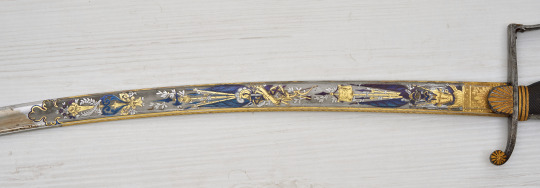
Magnificent and important Sabre of Leopold II of Habsburg-Lorraine, Grand Duke of Tuscany (1824-1859).
Iron hilt with gilt rosettes and the crowned cipher "L II" of Grand Duke Leopold II of Tuscany.
The grip of cut black ebony panels. The pommel, grip finish, and the guard of the quillons gilded.
Truly magnificent edged blade with polychrome blued and richly gilded decorative etching on both sides depicting trophies of arms, flags, crossed rifles, and rich arabesque decoration.
Iron scabbard with gilt fittings with sun symbols and the gilt inscription: "Firenze 18 Giugno 1844". On two suspension rings. Total length: 98.5 cm.
Leopold was born the second son of Grand Duke Ferdinand III and his first wife Luisa Maria of Naples-Sicily in Florence, Palazzo Pitti. Married to Princess Maria Anna of Saxony since 1817, he succeeded his late father in government on 18 June 1824. After the death of his beloved first wife Maria Anna, the Grand Duke married Princess Maria Antonia of Naples-Sicily on 7 June 1833. Maria Antonia bore ten children within eighteen years, six of whom reached adulthood, two daughters and four sons. The revolutions of 1847/1848 in the context of the Risorgimento moved him to issue a constitution on 15 February 1848. However, it was not sufficient for the radical forces in the population, who wanted to completely eliminate Austrian rule. Leopold II then left the country in February 1849 and a provisional republican government was formed, which briefly allied itself with the revolutionary Roman Republic that had existed in the Papal States for about five months at the same time. Already in April, the attempt at a republican democracy in Tuscany was crushed by a counter-revolution initiated by Austrian troops and the Grand Duke was able to return. In April 1859, a popular uprising tried to force him to join the Kingdom of Sardinia-Piedmont in the Sardinian War against Austria. As Leopold II had pledged neutrality towards Austria, he left Tuscany with his family on 27 April and abdicated on 21 July 1859 in favour of his son Ferdinand IV from his second marriage. However, Ferdinand no longer ruled the Grand Duchy, as Tuscany joined the Kingdom of Sardinia after a referendum in 1860, thus ending the rule of the House of Habsburg-Lorraine-Tuscany
Source: The Sale Room
35 notes
·
View notes
Text
MARÍA ISABEL OF SPAIN
Queen Consort of the Two Sicilies
(born 1789 - died 1848)
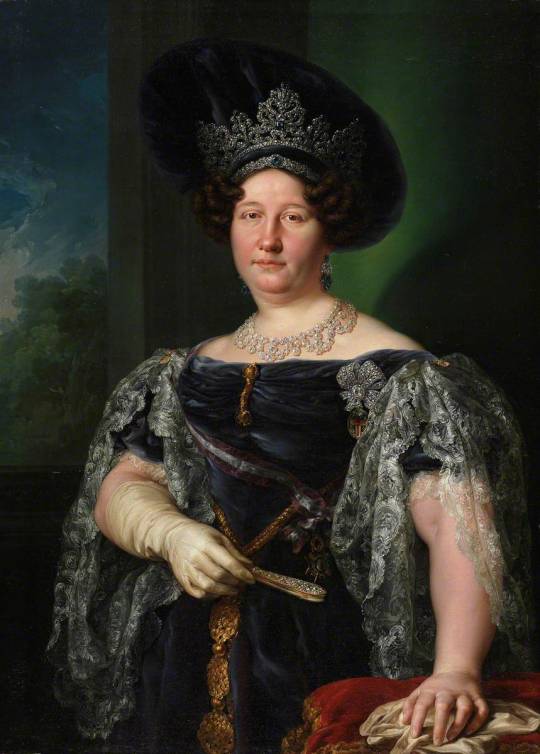
pictured above is a portrait of the Queen of the Two Sicilies, by Vicente López Portaña from 1829
-------------------- ~ -------------------- ~ --------------------
SERIES - On this day September Edition: María Isabel died on 13 September 1848.
-------------------- ~ -------------------- ~ --------------------
MARÍA ISABEL ANTONIA JOSEFA ANA TERESA FILIPINA was born in 1789, at the Royal Palace of Madrid. She was one of the youngest daughters of Carlos IV, King of Spain and Princess Maria Luisa of Parma.
Born a member of the Spanish branch of the HOUSE OF BOURBON, she was an INFANTA OF SPAIN from birth.
She was married to her first cousin FRANCESCO GENNARO GIUSEPPE SAVERIO GIOVANNI BATTISTA in 1802 and they had twelve children (check the list below). He was the Duke of Calabria as the Hereditary Prince Royal of the Kingdom of the Two Sicilies. She was 13 years old while he was already a widower aged 25 and his late wife was another first cousin of both of them, Archduchess Maria Klementine of Austria, with whom he already had two children.
Her new mother-in-law Archduchess Maria Karolina of Austria opposed to the wedding because Spain was allied to the French Republic, against the Austrian/British/Naples alliance.
After her wedding she became the DUCHESS OF CALABRIA and the HEREDITARY PRINCESS ROYAL CONSORT OF THE TWO SICILIES.
France had been a treat to Naples since the French Revolution. And in 1806 Napoléon I, Emperor of the French invaded Naples, deposed her father in-law Ferdinando IV, King of Naples, forced the Neapolitan Royal Family to exile in Sicily and put his own brother Joseph Bonaparte on the Neapolitan throne as Giuseppe, King of Naples.
Less then two years later Emperor Napoléon I also deposed her brother Fernando VII, King of Spain. Joseph Bonaparte was then removed from the Neapolitan throne and became José I, King of Spain. And in Naples the Emperor placed his brother-in-law Joachim Murat as Gioachinno, King of Naples.
The Neapolitan Royals fought against France but continued to be exiled in Sicily until they were allowed to return to Naples in 1815, after Napoléon's defeat and exile.
In 1816 her father-in-law was fully restored to the throne of Naples by the Congress of Vienna and by the end of the year the Kingdoms of Naples and Sicily were unified, creating the Kingdom of the Two-Sicilies. And her father-in-law became Ferdinand I, King of the Two Sicilies.
By 1825 her father-in-law died and husband succeeded as Francesco I, King of the Two Sicilies and she became the QUEEN CONSORT OF THE TWO SICILIES.
Six years later, in 1830, her husband died and was succeeded by their son as King Ferdinando II. And aged only 36, the QUEEN MOTHER OF THE TWO SICILIES soon engaged in love affairs.
Later in life she expressed the desire to remarry and her son, the King, agreed but make a list of possible suitors. She chose a younger Neapolitan general, FRANCESCO and married him privately in 1839. He was one of the sons of Nicola of Balzo, 3rd Duke of Presenzano and Caterina Crivelli and was created Count of Balzo. So she also became the COUNTESS OF BALZO. And do do her age they did not have any children.
Nine years after her second marriage, in 1848, the Queen Mother of the Two Sicilies died aged 59, at the Palace of Portici in Naples.
-------------------- ~ -------------------- ~ --------------------
Check my post about MARÍA ISABEL's children and their Royal Weddings!
MARÍA ISABEL and her first husband FRANCESCO I had twelve children...
Princess Luisa Carlotta of the Two Sicilies - wife of Infante Francisco de Paula of Spain;
Princess Maria Cristina of the Two Sicilies - wife first of Fernando VII, King of Spain and second of Agustín Fernando Muñoz and Sánchez, 1st Duke of Riánsares;
Ferdinando II, King of the Two Sicilies - husband first of Princess Maria Cristina of Sardinia and second of Archduchess Maria Theresia of Austria;
Carlo Ferdinando, Prince of Capua - husband of Penelope Smyth;
Leopoldo, Count of Syracuse - husband of Princess Maria Vittoria of Savoy;
Princess Maria Antonia of the Two Sicilies - wife of Leopoldo II, Grand Duke of Tuscany;
Antonio, Count of Lecce - unmarried;
Princess Maria Amalia of the Two Sicilies - wife of Infante Sebastián of Spain and Portugal;
Princess Maria Carolina of the Two Sicilies - wife of Carlos Luis, Count of Montemolín;
Princess Teresa Cristina of the Two Sicilies - wife of Pedro II, Emperor of Brazil;
Luigi, Count of Aquila - husband of Princess Januária of Brazil; and
Francesco, Count of Trapani - husband of Princess Maria Isabella of Tuscany.
-------------------- ~ -------------------- ~ --------------------
Two of her granddaughters named Isabel were supposed to become Monarchs in their own rights:
in 1883 Isabel II, Princess of Asturias succeeded as Isabel II, Queen of Spain; but
in 1889 Isabel, Princess Imperial of Brazil lost her rights of succession after the Monarchy was abolished in Brazil.
#maria isabel of spain#infanta of spain#infanta de espana#queen of the two sicilies#two sicilies#house of bourbon#bourbon#spanish royals#spanish royal family#royals#royalty#monarchies#monarchy#royal history#spanish history#european history#world history#history#history lover#18th century#19th century#napoleon i#napoleonic era#napoleonic wars#charles iv#ferdinand i#history by laura
3 notes
·
View notes
Text
Master Post - Members by birth
Disclaimer: Houses that rule(d)/reside(d) in other countries but originally came from German and/or Austrian territories and/or are generally regarded as belonging to this cultural room are listed among the German & Austrian Houses.
German & Austrian Houses
House of Ascania
Princess Sophie of Anhalt-Zerbst aka Catherine the Great
House of Coburg (Cadet branch of the House of Wettin)
Princess Alice of the United Kingdom, The Grand Duchess of Hesse and by Rhine
Princess Antoinette of Saxe-Coburg-Saalfeld, Duchess of Württemberg
Princess Charlotte of Belgium, The Empress of Mexico, Archduchess of Austria
Princess Stéphanie of Belgium, Crown Princess of Austria, Hungary & Bohemia
Princess Victoria of Great Britain and Ireland, Princess Royal, The German Empress
Victoria of Saxe-Coburg-Saalfeld, The Princess of Leiningen, The Duchess of Kent
House of Griffin
Elizabeth of Pomerania, Holy Roman Empress
House of Habsburg
Archduchess Johanna of Austria, The Grand Duchess of Tuscany
Archduchess Maria Amalia of Austria, Holy Roman Empress, The Electress of Bavaria
Archduchess Maria Anna of Austria, Princess of Lorraine and Bar
Archduchess Maria Antonia of Austria, The Electress of Bavaria
Archduchess Maria Antonia “Marie Antoinette” of Austria, The Queen of France and Navarre
Archduchess Maria Leopoldine of Austria, The Empress of Brazil, Queen of Portugal & the Algarves
Maria Theresia, The Archduchess of Austria, Holy Roman Empress
Archduchess Sophie of Austria
House of Hanover (Cadet branch of the House of Welf)
Princess Sophia Dorothea of Hanover, The Queen in Prussia
Queen Victoria of the United Kingdom, Empress of India
House of Hesse
Princess Alix of Hesse and by Rhine, Empress Alexandra Feodorovna of Russia
Princess Elisabeth of Hesse and by Rhine, Grand Duchess Elizabeth Feodorovna of Russia
House of Hohenlohe-Langenburg
Princess Adelheid of Hohenlohe-Langenburg, The Duchess of Schleswig-Holstein
Princess Feodora of Hohenlohe-Langenburg, The Duchess of Saxe-Meiningen
House of Hohenstaufen
Elisabeth “Beatrix” of Swabia, The Queen of Castile, León & Galicia
Konstanze “Anna” of Hohenstaufen, The Empress of Nicaea
House of Hohenzollern
Princess Anna Amalia of Prussia
Princess Caroline of Ansbach, The Queen of Great Britain & Ireland, The Electress of Hanover
Princess Elisabeth of Brandenburg, The Duchess of Brunswick-Calenberg-Göttingen
Princess Luise of Prussia, Princess Radziwiłł
Princess Maria Eleonora of Brandenburg, The Queen of Sweden
Princess Marie of Prussia, The Queen of Bavaria
Princess Wilhelmine of Prussia, The Margravine of Brandenburg-Bayreuth
House of La Marck
Amalia of Cleves
Anne of Cleves, The Queen of England
Sybille of Cleves, The Electress of Saxony
House of Leiningen
Princess Feodora of Leiningen, The Princess of Hohenlohe-Langenburg
House of Liechtenstein
Princess Sophie of Liechtenstein, Countess Esterházy de Galantha
House of Mecklenburg
Charlotte of Mecklenburg-Strelitz, The Queen of Great Britain, Ireland & Hanover
Elisabeth of Mecklenburg-Schwerin, Princess of Brunswick-Lüneburg aka Grand Duchess Anna Leopoldovna of Russia
Friederike (Federica) of Mecklenburg-Strelitz, The Queen of Hanover
Louise of Mecklenburg-Strelitz, The Queen of Prussia
Therese of Mecklenburg-Strelitz, The Princess of Thurn and Taxis
House of Northeim
Richenza of Northeim, Holy Roman Empress
House of Oldenburg
Augusta Victoria of Schleswig-Holstein, German Empress
Princess Cecilie of Greece & Denmark, The Hereditary Grand Duchess of Hesse and by Rhine
House of Reuß
Princess Hermine Reuß of Greiz, “German Empress”
House of Thurn and Taxis
Princes Marie Auguste of Thurn and Taxis, Duchess of Württemberg
House of Welf
Adelaide of Burgundy, Holy Roman Empress, Queen of Italy
Princess Caroline of Brunswick-Wolfenbüttel, The Queen of the United Kingdom & Hanover
Elisabeth Christine of Brunswick-Wolfenbüttel, Holy Roman Empress
Elisabeth Christine of Brunswick-Wolfenbüttel-Bevern, The Queen in & of Prussia
Princess Juliane of Brunswick-Wolfenbüttel-Bevern, The Queen of Denmark and Norway
House of Wettin
Adelheid (Adelaide) of Saxe-Meiningen, The Queen of the United Kingdom and Hanover
Princess Augusta of Saxe-Weimar-Eisenach, German Empress
Princess Christina of Saxony, The Landgravine of Hesse
Princess Luise (Louise) of Saxe-Gotha-Altenburg, The Duchess of Saxe-Coburg-Saalfeld, The Countess of Pölzig and Beiersdorf
House of Wied-Neuwied
Princess Elisabeth of Wied, The Queen & Princess of Romania
House of Wittelsbach
Princess Alexandra of Bavaria
Princess Amalie Auguste of Bavaria, The Queen of Saxony
Eleonore Magdalene of Neuburg, Holy Roman Empress
Elisabeth “Sisi” in Bavaria, The Empress of Austria
Elisabeth (Isabeau) of Bavaria, The Queen of France
Princess Elisabeth Ludovika of Bavaria, The Queen of Prussia
Helene “Néné” in Bavaria, The Hereditary Princess of Thurn and Taxis
Princess Ludovika of Bavaria, The Duchess in Bavaria
Princess Maria Anna of Bavaria, The Archduchess of Inner Austria-Styria
Princess Maria Anna of Bavaria, The Queen of Saxony
Marie in Bavaria, The Queen of Two Sicilies
Baroness Marie Louise of Wallersee, Countess of Larisch
Mathilde in Bavaria, The Countess of Trani
Sophie in Bavaria, The Duchess of Alençon
Princess Sophie of Bavaria, Archduchess of Austria
House of Württemberg
Mary of Teck, The Queen of the United Kingdom & British Dominions, Empress of India
Princess Sophie of Württemberg, The Queen of the Netherlands
Minor Nobles
Anna Constantia of Brockdorff, The Imperial Countess of Cosel
Katharina von Bora, Mrs Martin Luther
Baroness Louise Lehzen
Baroness Marie “Mary” of Vetsera
Sophie Botta, The Dark Countess of Hildburghausen
Sophie of Pannwitz, Countess of Voß
Foreign Houses
House of Albret
Jeanne d’Albret, The Queen of Navarre, 1. The Duchess of Jülich-Cleves-Berg and 2. The Duchess of Vendôme
House of Aviz
Infanta Eleonor of Portugal, Holy Roman Empress
House of Bourbon
Princess Louise d’Orléans, Princess Alfons of Bavaria
Byzantine Imperial Family
Princess Eudokia Laskarina of Nicaea, The Hereditary Duchess of Austria
Irene of Byzantium, The Queen of the Germans, The Duchess of Swabia
Princess Theodora Angelina, The Duchess of Austria & Styria
Princess Theodora Komnene of Byzantium, The Duchess of Bavaria & Austria
Theophanu, Holy Roman Empress
House of Chotek
Countess Sophie Chotek of Chotkowa and Wognin, The Duchess of Hohenberg
House of Este
Maria Beatrice d’Este, The Duchess of Massa & Carrara, Archduchess of Austria
House of Jagiellon
Jadwiga (Hedwig) Jagiellon, The Electress of Brandenburg
House of Stuart
Elizabeth Stuart, The Queen of Bohemia & Electress Palatine
House of Trastámara
Queen Joanna “The Mad” of Castile, Léon & Aragon, The Duchess of Burgundy, Archduchess of Austria
House of Valois
Mary, The Duchess of Burgundy, Archduchess of Austria
Commoners
Fatima Kariman aka Maria Aurora (von) Spiegel
Helene Baltazzi, The Baroness of Vetsera
Louise Rump, Mrs Ebert
Margot Großmann, Mrs Sauerbruch
Maria Anna Mozart, The Imperial Baroness Berchthold
Maria “Mizzi” Kaspar
Ottilie Richter, Baroness of Faber
Sophie Scholl
35 notes
·
View notes
Photo
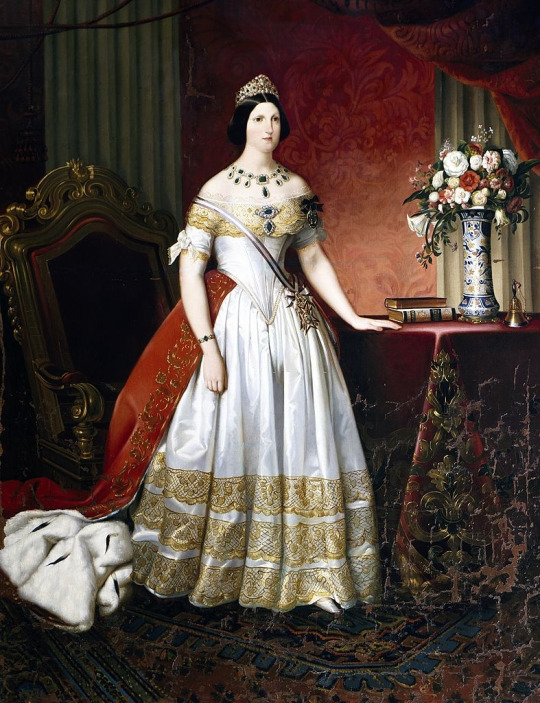
Carlo Morelli - Maria Antonia of the Two Sicilies, Grand Duchess of Tuscany
Princess Maria Antonia Giuseppa Anna of the Two Sicilies (19 December 1814 – 7 November 1898) was the Grand Duchess of Tuscany from 1833 to 1859 as the consort of Leopold II. In signature, she used Maria Antonietta.
#Maria Antonia of the Two Sicilies#House Bourbon-Two Sicilies#XIX century#Carlo Morelli#people#portrait#paintings#art#arte
1 note
·
View note
Photo
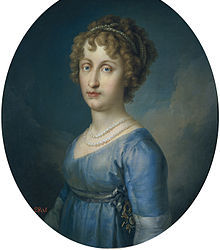
People that have married in to Royal Families since 1800 Spam
Spain
Princess Maria Antonia of Naples and Sicily
Maria Antonia of Naples and Sicily was the youngest daughter of Ferdinand, King of Naples and Sicily, and Maria Carolina of Austria. As the wife of the future Ferdinand VII of Spain, then heir apparent to the Spanish throne, she held the title of Princess of Asturias.
She was known as Maria Antonia and was born at the Caserta Palace in Caserta, Italy. Named after her mother's favorite sister, Queen Marie Antoinette of France, she was an intelligent girl, having by the age of seventeen learned several languages.
In a series of dynastic alliances, Maria Antonia became engaged to Infante Ferdinand, Prince of Asturias (who later became King Ferdinand VII of Spain), while her eldest brother, Francis, became engaged to Infante Ferdinand's sister Infanta Maria Isabella of Spain. On 6 October 1802, Maria Antonia married Infante Ferdinand in Barcelona, Spain.
The princess failed to provide the expected heir to the throne: her two pregnancies, in 1804 and 1805, ended in miscarriages. Her mother, Maria Carolina, was highly anti-French after the execution of her sister and brother-in-law during the French Revolution. She was also strongly opposed to the military expansion of the French republic. As Spain became more easily dominated by Napoleon Bonaparte, there were rumours that Maria Carolina wanted her daughter to poison the Queen of Spain and Manuel Godoy, Spain's prime minister.
However, as with most poison rumours of the period, it is unlikely to be true, not least because both women were devout Roman Catholics and secondly because the Spanish court's ties to France were in no way greater or lesser than most in Europe's after Bonaparte's early victories. Maria Antonia's mother-in-law, Queen Maria Luisa, disliked her daughter-in-law and she encouraged rumours of a Habsburg poisoning plot, even subjecting her books and clothes to scrutiny in order to discredit her daughter-in-law further. In spite of all of this campaign of character assassination, Maria Antonia managed to gain considerable influence over her husband and created an opposition party against Queen Maria Luisa and Godoy
She died of tuberculosis on 21 May 1806 at the Royal Palace of Aranjuez in Aranjuez, Spain. It was rumoured that Maria Antonia had been poisoned by Maria Luisa and Godoy, although again there is no actual evidence. However, Queen Maria Carolina, who was devastated, truly believed this. Maria Antonia's father, King Ferdinand, consolidated Naples and Sicily into the Kingdom of the Two Sicilies a decade after her death. The Neapolitan princess was buried at El Escorial in Spain.
1 note
·
View note
Text
King Felipe VI of Spain and Archduchess Isabella’s relations
King Felipe and Isabella are double fourth cousins once removed from King Christian IX of Denmark through his children Thrya and son George of Greece , fourth cousins once removed from King Ferdinand II of the Two Sicilies, sixth cousin and sixth cousins once removed from Francis, Duke of Saxe Coburg Salfield, sixth cousins once removed from Leopold II, Holy Roman Emperor, seventh cousins once removed from Philip, Duke of Parma, and eighth cousins once removed as the descendant of Philip V of Spain.
King Christian IX of Denmark
King Felipe:
Christian IX -> George I of Greece -> Constantine I of Greece -> Paul I of Greece -> Queen Sofia of Spain -> King Felipe
Christian IX -> Princess Thyra of Denmark -> Ernest Augustus, Duke of Brunswick -> Queen Frederica of Greece -> Queen Sofia of Spain -> King Felipe
Archduchess Isabella:
Christian IX of Denmark -> Frederick VIII of Denmark -> Princess Ingeborg of Denmark -> Queen Astrid -> Josephine Charlotte, Grand Duchess of Luxembourg -> Archduchess Marie Astrid of Austria -> Archduchess Isabella of Austria
King Ferdinand II of Bourbon-Two Sicilies
King Felipe:
King Ferdinand II -> Prince Alfonso, Count of Caserta -> Prince Carlos of Bourbon-Two Sicilies -> Princess Maria of Bourbon-Two Sicilies, Countess of Barcelona -> King Juan Carlos of Spain -> King Felipe
Archduchess Isabella:
King Ferdinand II -> Princess Maria Annunciata of Bourbon-Two Sicilies -> Archduke Otto Franz of Austria -> Charles I of Austria -> Archduke Carl Ludwig of Austria -> Archduke Carl Christian of Austria -> Archduchess Isabella
Francis, Duke of Saxe-Coburg-Saalfeld
King Felipe:
Francis, Duke of Saxe-Coburg-Saalfeld -> Victoria, Duchess of Kent -> Queen Victoria -> Princess Beatrice -> Queen Victoria Eugenie of Spain -> Infante Juan, Count of Barcelona -> King Juan Carlos of Spain -> King Felipe
Francis, Duke of Saxe-Coburg-Salfeed-> Victoria, Duchess of Kent -> Queen Victoria -> Empress Frederich-> Sophia of Prussia, Queen of Greece -> King Paul of Greece -> Queen Sofia of Spain -> King Felipe
Francis, Duke of Saxe-Coburg-Salfeed-> Victoria, Duchess of Kent -> Queen Victoria -> Empress Frederich-> Kaiser Wilhelm II -> Victoria Louise of Prussia -> Queen Frederica of Greece -> Queen Sofia of Spain -> King Felipe
Archduchess Isabella:
Francis, Duke of Saxe-Coburg-Saalfeld -> Leopold I of Belgium -> Prince Philippe, Count of Flanders -> Albert I of Belgium -> Leopold III of Belgium -> Josephine Charlotte of Belgium, Grand Duchess of Luxembourg -> Archduchess Marie Astrid of Austria -> Archduchess Isabella of Austria
Leopold II, Holy Roman Emperor
King Felipe:
Leopold II, Holy Roman Emperor -> Archduke Charles, Duke of Teschen -> Archduke Karl Ferdinand of Austria -> Archduchess Maria Christina of Austria, Queen of Spain -> King Alfonso XIII of Spain -> Infante Juan, Count of Barcelona -> King Juan Carlos of Spain -> King Felipe
Archduchess Isabella
Leopold II, Holy Roman Emperor -> Francis II, Holy Roman Emperor -> Archduke Franz Karl of Austria -> Archduke Karl Ludwig -> Archduke Karl Ludwig of Austria -> Archduke Otto Franz of Austria -> Emperor Charles I of Austria -> Archduke Carl Ludwig of Austria -> Archduke Carl Christian of Austria -> Archduchess Isabella of Austria
Philip, Duke of Parma
King Felipe:
Philip, Duke of Parma -> Maria Luis, Queen of Spain -> Infante Francisco de Paula of Spain -> Infante Francisco de Asis of Spain -> Alfonso XII of Spain -> Alfonso XIII of Spain -> King Alfonso XIII of Spain -> Infante Juan, Count of Barcelona -> King Juan Carlos of Spain -> King Felipe
Isabella:
Philip, Duke of Parma -> Ferdinand, Duke of Parma -> King Louis I of Eturia -> Charles II, Duke of Parma -> Charles III, Duke of Parma -> Robert I, Duke of Parma -> Felix of Bourbon-Parma -> Jean, Grand Duke of Luxembourg -> Archduchess Marie Astrid of Luxembourg -> Archduchess Isabella
Philip, Duke of Parma -> Ferdinand, Duke of Parma -> King Louis I of Eturia -> Charles II, Duke of Parma -> Charles III, Duke of Parma -> Robert I, Duke of Parma -> Empress Zita -> Archduke Carl Ludwig of Austria -> Archduke Carl Christian -> Archduchess Isabella
Philip V of Spain
King Felipe:
King Philip V of Spain -> King Charles III of Spain -> King Charles IV of Spain -> Infante Francisco de Asis of Spain -> Alfonso XII of Spain -> Alfonso XIII of Spain -> King Alfonso XIII of Spain -> Infante Juan, Count of Barcelona -> King Juan Carlos of Spain -> King Felipe
Archduchess Isabella:
King Philip V of Spain -> Maria Antonia of Spain, Queen of Sardinia -> King Victor Emmanuel I of Sardinia -> Princess Maria Teresa of Savoy -> Charles III, Duke of Parma -> Robert I, Duke of Parma -> Felix of Bourbon-Parma -> Jean, Grand Duke of Luxembourg -> Archduchess Marie Astrid of Luxembourg -> Archduchess Isabella
King Philip V of Spain -> Maria Antonia of Spain, Queen of Sardinia -> King Victor Emmanuel I of Sardinia -> Princess Maria Teresa of Savoy -> Charles III, Duke of Parma -> Robert I, Duke of Parma -> Empress Zita -> Archduke Carl Ludwig of Austria -> Archduke Carl Christian -> Archduchess Isabella
2 notes
·
View notes
Text

Maria Antonia of Naples and Sicily, Princess of Asturias.
#Maria Antonia of Naples and Sicily#princess of asturias#house of bourbon two sicilies#spanish royal family#long live the queue
7 notes
·
View notes
Text
some messy, unconnected au thoughts:
the American, French, and Russian revolutions are all definitely still going to happen, I’m lazy so I’m going to gloss over the details, they don’t go precisely the same way but the more-or-less-ness of it is the same
I know the most about the lead up to the French revolution, for example:
Princess Eleanor of England (daughter of Charles III and Maria Magdalena of Austria) becomes Dauphine of France in 1744 upon her marriage to Louis le Dauphin (son of Louis XV and Marie Leszczyńska) and they had:
Louis, Duke of Burgundy (b. 1746)
Marie Elisabeth (b. 1747) - died of smallpox at age ten
Eleanor (b. 1752) - became Queen of Sardinia in marriage to Charles Emmanuel IV
Louise Marie (b. 1753) - became Queen of Saxony in marriage to Frederick Augustus I of Saxony
Marie Charlotte (b. 1754) - became Queen of Portugal in marriage to Afonso VII
Charles, Count of Provence and Philippe (b. 1757) - Philippe was a sickly baby and died after two weeks
Henri, Count of Artois (b. 1758) - married Princess Maria Theresa of Savoy
Marguerite (b. 1762) - unmarried and probably a lesbian
I’m struggling with myself about whether Louis is going to be promised in marriage to Maria Antonia or Maria Carolina (in any case, the sister ends up marrying Charles instead, Louis shockingly dying two weeks before the archduchess is intended to leave Austria) because I know Maria Theresa chose Antonia for France because she was the prettiest and that Maria Carolina was replacing her older sister Maria Josepha who had been intended to marry Ferdinand I of the Two Sicilies
but if Eleanor is still alive, she’s going to be the person Charles looks to for guidance and I have her slated to outlive her husband and father-in-law and in that case, it really doesn’t matter which sister it is, they’re not going to be given much of a say and are going to be scapegoated by the French public
though I do like the idea of Maria Antonia not involving herself in the administration of the Neapolitan state and things consequently going far more south there, the idea of the French revolution spreading outside of France is terrifying but fascinating
hmmm....
if Eleanor dies in 1788 then Charles would definitely lean on his wife, who Eleanor took under her wing, and then it would be very fun to see Maria Carolina and her enlightened absolutism agenda come into power just before the OTL start of the revolution (plus the spillage from Maria Antonia in Naples and Sicily) okay, yeah, I like that quite a lot
I don’t subscribe to the great man theory of history but I do think we’d see Napoleon rising here though his reign/success would be a bit different
moving on to Russia, I don’t know quite a lot but because we’ve butterflied Victoria out of existence, the hemophilia angle and Rasputin are going to not exist either
America, honestly, idk, Maximilian I is on the throne but he dies in 1775 and Charles IV ascends to the throne so maybe there would be a hope that the new king would more lenient/encouraging to their cause? However I don’t see Parliament acting all that differently, so ???
moving out of revolution, I really need to start working on royal mistresses (I’m imagining what the akingswhore blog would look like in this world): the only three I’ve thought about are that the eldest son of Lady Mary (daughter of Anne of York and George of Denmark) was associated with and infatuated with soprano Cecilia Young though whether they had a physical relationship is hotly debated by historians; Charles III has a few dalliances/affairs/whatever you want to call it but only one was a more then one time thing and this was all before his marriage but you’ll still see fringe historians insisting that she was the love of his life (I don’t have a name for her yet); & then I already mentioned that Henry X openly had a married mistress, Amelia something, who was married to the Earl of Harewood (note: not the same Earl of Harewood as OTL because our 7th Earl was the son of Mary, Princess Royal, daughter of George V but born around the same time).
oh, right, and Parliament never passes the Act of Settlement (they had no reason to) and so the Stuarts continue to marry Roman Catholics/non-Protestants though they actually didn’t marry too many
0 notes
Photo

A lithograph of Princess Maria Antonia of the Two Sicilies, Grand Duchess of Tuscany.
#Princess Maria Antonia of the Two Sicilies#grand duchess of tuscany#lithogaph#house of bourbon two sicilies#Maria Antonietta of the two sicilies#long live the queue
11 notes
·
View notes
Photo
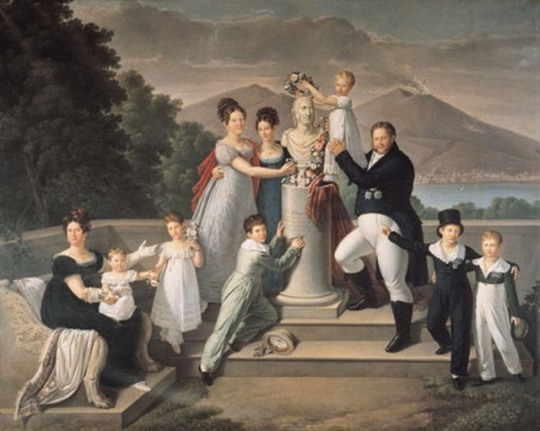
A portrait of the family of Francis I of Naples and Sicily. It was comissioned as a gift for his father, Ferdinand IV, who is dipected in the bust in the centre.
His wife, Maria Isabella of Spain, is seated on the left, with baby Maria Carolina in her lap. She gestures to Maria Antonia, holding a boquet of flowers. Luisa Carlotta and Maria Christina are embracing one another next to the bust of their grandfather. At the base of the bust is their eldest son and heir, the future Ferdinand II.
On the right of the bust Francis holds up Maria Amalia, who is crowing the bust with a garland of flowers. Next to him are two their two other sons, Leopold and Charles
Painted in 1820 by Giuseppe Cammarano, the painting oddly doesn’t include their son Antonio, who would have been four at the time and was born between Maria Antonia and Maria Amalia.
The couple would have three more children after this portrait was completed. A daughter named Teresa Cristina was born in 1822, followed by two sons, Louis (1824) and Francis (1827).
#francis i#maria isabella of spain#luisa carlotta of Naples and Sicily#Maria Christina of the Two Sicilies#ferdinand ii#Princess Maria Antonia of the Two Sicilies#Maria Amalia of Bourbon-Two Sicilies#Maria Carolina of Bourbon-Two Sicilies#prince leopold#prince charles#long live the queue
19 notes
·
View notes
Photo
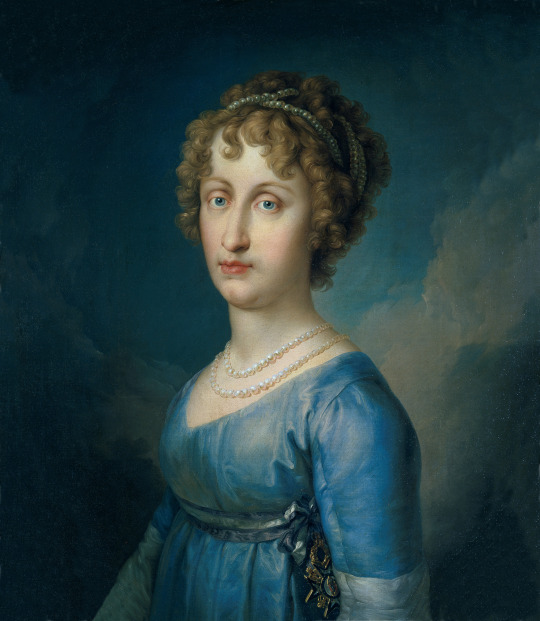
The Princess of the Asturias, without being pretty, had a charming, attractive personality. The Duchesse d'Abrantes, who saw her soon afterwards, says of her that no one would have supposed she could have been of Neapolitan blood. She had the blue eyes and fair hair of her Austrian mother and the Habsburg lip. She had the Bourbon nose, but not pronounced enough to be ugly. Though not tall she was extremely dignified, and when she smiled all her face seemed to light up ; and though reserved and rather silent, her face was exceedingly expressive and interesting. She was an excellent musician, spoke seven or eight languages, was passionately fond of poetry and painting, and amused herself almost entirely in various artistic and intellectual pursuits.
The Life Story of Marie Caroline, Queen of Naples - Mrs Bearne
#maria antonia of naples and sicily#Princess of Asturias#House of Bourbon-Two Sicilies#spanish monarchy#house of bourbon two sicilies#long live the queue
49 notes
·
View notes